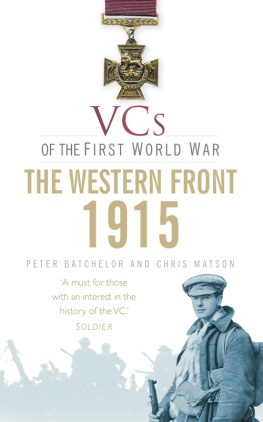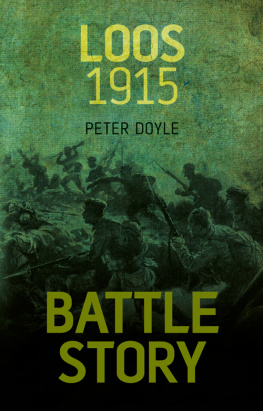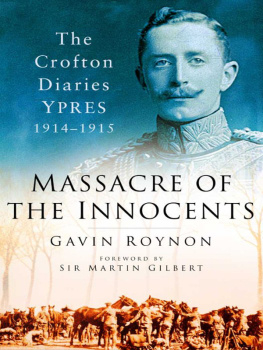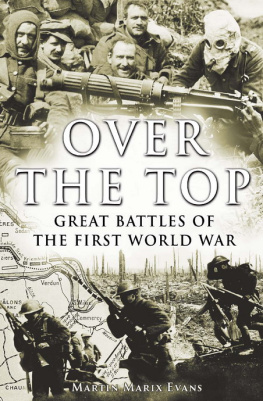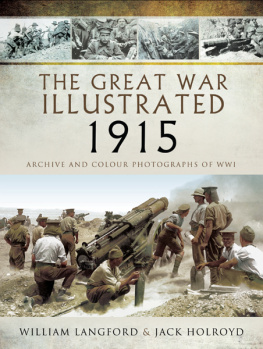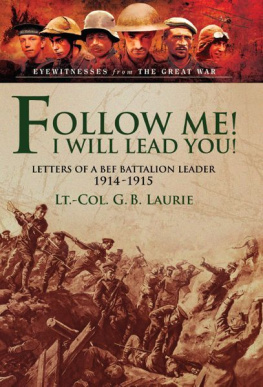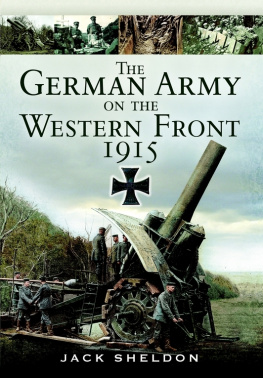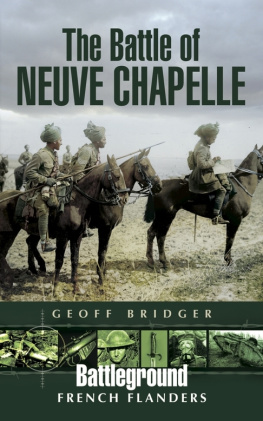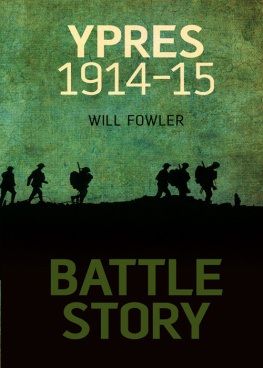
We would like to thank the staff at the following institutions for their help and patience during the research for this book: The Commonwealth War Graves Commission, Maidenhead; the Imperial War Museum, London; the National Army Museum, London; the Public Record Office, Kew; and the Royal Artillery Institution, London.
We have used Gallahers cigarette cards for the majority of the mens portraits. The artists impressions of the actions are drawn mostly from Deeds That Thrilled The Empire (Hutchinson, n.d.). Other illustrations have been obtained from the following: Bravest of the Brave ; Pearse and Sloman, History of the East Surrey Regiment (Medici Society, 1923); Illustrated London News ; Merewether and Smith, Indian Corps in France (John Murray, 1929); Hammerton, I Was There (Waverley, 1938); Lincolnshire Echo ; Sentinel ; G.H. Woolley, Sometimes a Soldier (Benn, 1963); Creagh/Humphries, The VC and DSO Standard Art Co., 1924); J. Smyth, The Story of the Victoria Cross (1963); The War Budget (The Daily Chronicle, 191418); Hammerton, The War Illustrated (Amalgamated Press, 191419); other photographs are provided by the Maple Leaf Legacy Project, Jim McGinlay at The Scottish Memorials Project, Nottingham and Nottinghamshire Victora Cross Committee, Dr. Judy Landau and Dave Stowe. Our thanks are due to Eric Gee for producing the scaled maps from various sources that we supplied. We have also received considerable assistance from the following individuals who have all helped in various ways: the late Edward Campbell, David Empson, Derek Hunt, Maurice Johnson and Steve Snelling. Our special thanks to Gerald Gliddon for his invaluable guidance and encouragement. We should also like to thank Brenda Gullett for word-processing the manuscript and to Pauline and Tim who helped her. Our wives Jean and Gill deserve special mention for their unfailing support.
CONTENTS
ADS | Advanced Dressing Station |
ASC | Army Service Corps |
BEF | British Expeditionary Force |
BVM | British Victory Medal |
BWM | British War Medal |
CAMC | Canadian Army Medical Corps |
CEF | Canadian Expeditionary Force |
CFA | Canadian Field Artillery |
CG | Coldstream Guards |
CIB | Canadian Infantry Brigade |
CO | Commanding Officer |
CRE | Commander Royal Engineers |
CSM | Company Sergeant Major |
DCM | Distinguished Conduct Medal |
DFC | Distinguished Flying Cross |
DLI | Durham Light Infantry |
DSO | Distinguished Service Order |
EEF | Egyptian Expeditionary Force |
GC | George Cross |
GG | Grenadier Guards |
GSO | General Staff Officer |
HLI | Highland Light Infantry |
IG | Irish Guards |
IOM | Indian Order of Merit |
KOSB | Kings Own Scottish Borderers |
KOYLI | Kings Own Yorkshire Light Infantry |
KRRC | Kings Royal Rifle Corps |
MC | Military Cross |
MG | Machine-gun |
MID | Mentioned in Despatches |
MM | Military Medal |
MO | Medical Officer |
OCA | Old Comrades Association |
OCTU | Officer Commanding Territorial Units |
OTC | Officer Training Corps |
QVR | Queen Victorias Rifles |
RAMC | Royal Army Medical Corps |
RB | Rifle Brigade |
RE | Royal Engineers |
RGA | Royal Garrison Artillery |
RIF | Royal Irish Fusiliers |
RNWMP | Royal North-West Mounted Police |
RSF | Royal Scots Fusiliers |
RWF | Royal Welsh Fusiliers |
SAA | Small Arms Ammunition |
VAD | Voluntary Aid Detachment |
VC | Victoria Cross |
The war was not over by Christmas as the 1914 slogan had proclaimed and by the end of that year the BEF were in the stalemate of trench warfare and fairly disillusioned about the prospect of a swift victory. The British troops had suffered badly in the early campaigns and by January 1915 were holding about 30 miles of actual trenches, a small fraction of that held by their French allies. Reinforcements were needed and General Sir John French, C-in-C of the BEF, felt under pressure to carry out some sort of offensive operation. This was prompted first by the withdrawal of German divisions from the Western to the Eastern Front and the fear of a decisive German victory over Russia, and secondly by the need to boost morale among his own troops.
Joffre, Frenchs counterpart in the French Army, also wanted the British to take a greater part in the drive to oust Germany from conquered areas. Initially, to facilitate French Army plans for action in the New Year, Joffre demanded the relief of French units north of Ypres by British troops so that French troops belonging to the same Army group were not separated by British units.
Sir John French had an initial meeting in January 1915 with Joffre to air his proposals for offensive action. His idea of a swift knock-out blow using overwhelming numerical superiority and a short, heavy artillery barrage to precede the attack at Neuve Chapelle fitted in well with Joffres plans and showed a willingness on the part of the British to take some of the burden of the war. The battle was to be a British show with limited French artillery in support. Forty-eight battalions on a narrow frontage were to be launched against a mere nine German battalions opposite. Morale among the attackers was high; the promise of victory, given the favourable odds and the elation created by the heavy barrage on the enemy positions, gave the troops confidence. Initially, despite setbacks on each flank, the main thrust of the attack was successful and broke through the lines. All the ground won in this battle was taken in the first three hours. The tragedy was that there was no swift follow-up of the advantages achieved. The rolling-up of the line from behind was not realised. Neuve Chapelle was to be the first of a number of British actions that year in which the Germans seemed to learn lessons more quickly than the British Command.
The same principle as employed at Neuve Chapelle was used again with minor modifications in the later offensives of Aubers Ridge and Festubert but without the success realised on the first day of Neuve Chapelle. Prior to these two battles the British attacked successfully at Hill 60 on 17 April. German determination to protect the gas cylinders secretly laid in readiness for a general attack against Ypres and the need to retain the vantage point of the hill for artillery spotting in bombarding the Ypres area, led to savage fighting and outstanding bravery on both sides, resulting in the awarding of several VCs including Woolley, the first Territorial VC, before the British were finally driven off the hill.
Next page
